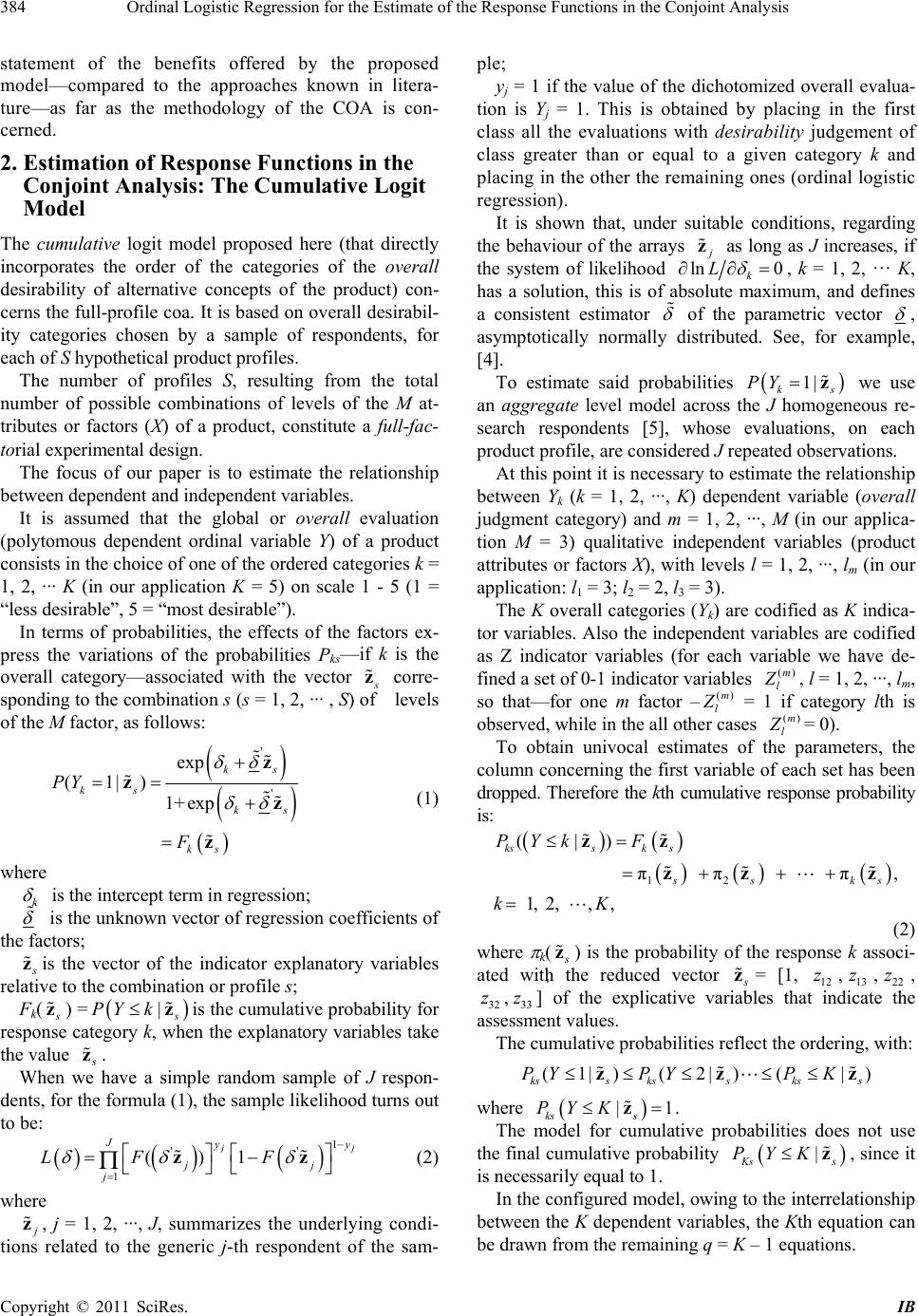
Ordinal Logistic Regression for the Estimate of the Response Functions in the Conjoint Analysis
384
statement of the benefits offered by the proposed
model—compared to the approaches known in litera-
ture—as far as the methodology of the COA is con-
cerned.
2. Estimation of Response Functions in the
Conjoint Analysis: The Cumulative Logit
Model
The cumulative logit model proposed here (that directly
incorporates the order of the categories of the overall
desirability of alternative concepts of the product) con-
cerns the full-profile coa. It is based on overall desirabil-
ity categories chosen by a sample of respondents, for
each of S hypothetical product profiles.
The number of profiles S, resulting from the total
number of possible combinations of levels of the M at-
tributes or factors (X) of a product, constitute a full-fac-
torial experimental design.
The focus of our paper is to estimate the relationship
between dependent and independent variables.
It is assumed that the global or overall evaluation
(polytomous dependent ordinal variable Y) of a product
consists in the choice of one of the ordered categories k =
1, 2, ··· K (in our application K = 5) on scale 1 - 5 (1 =
“less desirable”, 5 = “most desirable”).
In terms of probabilities, the effects of the factors ex-
press the variations of the probabilities Pks—if k is the
overall category—associated with the vector
z
corre-
sponding to the combination s (s = 1, 2, ··· , S) of levels
of the M factor, as follows:
'
'
exp
(1|)
1+ exp
ks
ks
ks
ks
PY
F
z
zz
z
(1)
where
k
is the intercept term in regression;
'
is the unknown vector of regression coefficients of
the factors;
z
is the vector of the indicator explanatory variables
relative to the combination or profile s;
Fk(
z) =
|
PY kz
is the cumulative probability for
response category k, when the explanatory variables take
the value
z
.
When we have a simple random sample of J respon-
dents, for the formula (1), the sample likelihood turns out
to be:
1
''
1
()1
j
Jyy
j
j
LF F
zz
j
(2)
where
z
, j = 1, 2, ···, J, summarizes the underlying condi-
tions related to the generic j-th respondent of the sam-
ple;
yj = 1 if the value of the dichotomized overall evalua-
tion is Yj = 1. This is obtained by placing in the first
class all the evaluations with desirability judgement of
class greater than or equal to a given category k and
placing in the other the remaining ones (ordinal logistic
regression).
It is shown that, under suitable conditions, regarding
the behaviour of the arrays
z
as long as J increases, if
the system of likelihood ln L0
k
, k = 1, 2, … K,
has a solution, this is of absolute maximum, and defines
a consistent estimator
of the parametric vector
,
asymptotically normally distributed. See, for example,
[4].
To estimate said probabilities s
we use
an aggregate level model across the J homogeneous re-
search respondents [5], whose evaluations, on each
product profile, are considered J repeated observations.
1|
k
PYz
At this point it is necessary to estimate the relationship
between Yk (k = 1, 2, ···, K) dependent variable (overall
judgment category) and m = 1, 2, ..., M (in our applica-
tion M = 3) qualitative independent variables (product
attributes or factors X), with levels l = 1, 2, ···, lm (in our
application: l1 = 3; l2 = 2, l3 = 3).
The K overall categories (Yk) are codified as K indica-
tor variables. Also the independent variables are codified
as Z indicator variables (for each variable we have de-
fined a set of 0-1 indicator variables ()m
l
, l = 1, 2, ···, lm,
so that—for one m factor –()m
l
= 1 if category lth is
observed, while in the all other cases ()m
l
= 0).
To obtain univocal estimates of the parameters, the
column concerning the first variable of each set has been
dropped. Therefore the kth cumulative response probability
is:
12
(|)
π π π,
1, 2, ,,
kssk s
ss k
PYk F
kK
zz
zz z
s
(2)
where
k(
z) is the probability of the response k associ-
ated with the reduced vector
z
= [1, 12 ,13 ,22 ,
32 ,33 ]'of the explicative variables that indicate the
assessment values.
zzz
z z
The cumulative probabilities reflect the ordering, with:
(1|)( 2|)(|
kss ksskss
PYPYP K)
zz
z
where
|1
ks s
PY K
z
.
The model for cumulative probabilities does not use
the final cumulative probability
|
s
PYKz
s
, since it
is necessarily equal to 1.
In the configured model, owing to the interrelationship
between the K dependent variables, the Kth equation can
be drawn from the remaining q = K – 1 equations.
Copyright © 2011 SciRes. IB